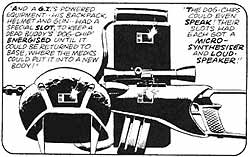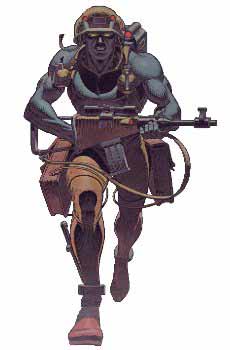
G.I. Musings
2003-07-03
There are rules to writing fiction that apply to all genres, and chief among these is the Suspension of Disbelief rule. If you're not familiar with the term, it goes something like this: the writer should do his or her best to avoid reminding the readers that they're reading. In other words, you don't put in stuff that makes the reader go "Huh?" or "You wot?"
For example, you don't use long words like sesquipedalian, because many readers won't know what it means, so it acts kind of like a literal speedbump. You also don't include too many Amazing Coincidences (like the way Luke Skywalker's uncle just happens to be the man who buys the robots from the Jawas, thus giving Luke a reason to go off looking for R2D2 where he coincidentally meets Obi Wan who used to be his father's best friend and who also used to own the robots and who happens to keep Luke away from home long enough for the stormtroopers to kill his aunt and uncle, etc.)
Likewise, you don't put stuff into your fiction that's so unlikely that the reader thinks, "Ah, now, come on!"
 That
said, in science fiction and related genres you're often allowed to get away with
stuff that's impossible or impractical, because the readers are conditioned to
expect it. Take the concept of teleportation, specifically as seen in Star
Trek: this thingy breaks down your body into its component molecules, transmits
it across vast distances and somehow reassembles it in working order. We all know
it's nonsense, but we accept it within the confines of the story.
That
said, in science fiction and related genres you're often allowed to get away with
stuff that's impossible or impractical, because the readers are conditioned to
expect it. Take the concept of teleportation, specifically as seen in Star
Trek: this thingy breaks down your body into its component molecules, transmits
it across vast distances and somehow reassembles it in working order. We all know
it's nonsense, but we accept it within the confines of the story.
But when a story goes too far and introduces pointless technology just for the sake of it, or just because it seems like a cool idea at the time, then the writer is walking on eggshells. In spiked boots. On thin ice. With an anvil on his head (and so on).
Right about now, the intelligent and attractive 2000 AD Review reader is probably thinking, "What the heck is Sprout on about now? He's really gone off the deep end this time. Wearing concrete boots. With an anvil on his head (etc.)" But fear not, for in the next paragraph Sprout magnificently manages to bludgeon the topic in the direction of 2000 AD...
 I've
never really taken to some aspects of Rogue Trooper. While the main character
himself is great, the backstory is borderline genius, and most of the adventures
are tremendous fun, there are some Amazing Coincidences that really get in the way.
I've
never really taken to some aspects of Rogue Trooper. While the main character
himself is great, the backstory is borderline genius, and most of the adventures
are tremendous fun, there are some Amazing Coincidences that really get in the way.
Let's start with the Genetic Infantrymen... They're all clones, right? And they all have, for some reason, nicknames. That's okay, I can accept that, and nobody has to die over it. Our hero is Rogue, and he has three buddies, whose names are Helm, Gunnar and Bagman. Unusual names, sure, but again that's something I can live with. These clones all have their personalities encoded on little computer chips, okay? And if a clone is killed these chips can be placed in various pieces of another clone's equipment. Carefully sidling around the Big Question, we arrive at the Amazing Coincidences...
- Amazing Coincidence #1:
Just
by sheer chance, Rogue's three buddies get killed. Three dead buddies, three available
bio-chip slots in Rogue's equipment. What if there'd been a fourth buddy? How would
Rogue decide which of them has to be left behind? (Although, thinking about it, the
dead buddies would also have bio-chip slots in their equipment so he could take
one of their helmets or guns.)
- Amazing Coincidence #2:
The bio-chip of the clone whose name is Helm gets put into Rogue's helmet,
Gunnar goes into his gun, and Bagman goes into his backpack. Note:
the characters have those nicknames before they get killed, so it's not
like they chose them afterwards to suit the equipment.
- Amazing Coincidence #3: After the massacre that killed his buddies, the clone whose nickname just happens to be Rogue decides to abandon the chain of command and turn rogue.
 I can
just about accept the first and third Amazing Coincidences, but the second?
Come on, guys! That's just silly! Even when I was reading this as a kid, I was going,
"Oh yeah, sure!"
I can
just about accept the first and third Amazing Coincidences, but the second?
Come on, guys! That's just silly! Even when I was reading this as a kid, I was going,
"Oh yeah, sure!"
On top of that, there were a couple of pretty questionable moments, such as the story with the trucks that follow microchips embedded in the road: Rogue uses his buddies' bio-chips to lead the trucks over the edge of a cliff or something. What does that tell us? The trucks are clever enough to detect road-embedded microchips, but they aren't clever enough to actually read the chips to see if they're the right kind?
As I said, there have been some absolutely top-notch stories in there too, and some truly fantastic artwork (so far I'm really enjoying the current tale, "Ghouls"), but it doesn't help that Rogue's history is all muddled and confusing as hell. The initial "hunt for the traitor general" came to a satisfactory ending when Rogue actually found him, but then there was all that stuff with Fr1day (and his good pals Yes2rday, Wedn3sday and Aweekfrom2morrow) and Tor Cyan.
It became so hard to figure out who was Rogue and who wasn't that the most recent stories are set back in the past, when it was just One Man and his Talking Hat, and this is a Good Thing. One of the unwritten but important rules of computer programming (which applies here because we're talking about microchips) is that if something works, you don't mess with it. The original Rogue Trooper wasn't perfect, but if a comic strip's most glaring flaw is that some of the characters' names are unlikely, then I reckon we can consider it a winner.


